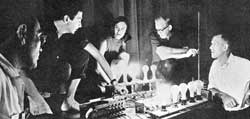Developing the ideal interface: artists and engineers

This photo was taken in 1966 during the nine-evening collaboration between artists and engineers commemorated in the Ellen Gallery show. In it Robert Rauschenberg and Lucinda Childs discuss the capabilities of the theatre electronic environmental modulator (TEEM) system with Herb Schneider, L.J. Robinson and Per Biorn.
Courtesy Experiments in Art and Technology (E.A.T).
It was mostly about language.
“When Artists and Engineers Meet: Divergencies in Concept and Process” was the theme of a panel discussion featuring two professors from Fine Arts, and two from Engineering and Computer Science. They were invited to consider the nature of collaboration between artists and computer scientists.
The discussion was moderated by Sylvie Lacerte, from the Daniel Langlois Foundation, as part of 9 Evenings Reconsidered: Art, Theatre and Engineering, 1966, currently on at the Leonard and Bina Ellen Gallery.
When all was said and done, finding a way to communicate was the biggest complication for collaboration.
“I really don’t understand artists, but I collaborate with them sometimes,” observed computer scientist Sudhir Mudur by way of introduction to his comments.
Later, Leila Sujir (Studio Arts) discussed her year as distinguished artist in residence at the University of Calgary’s Interactions lab. The space brings artists and computer programmers together to explore the role of software engineering in human/computer interface.
“When we first got together, we couldn’t even agree on a common problem, but we could identify directions we wanted to explore.”
Comments were made about the more formal language of science versus the varied forms of artistic expression. Joanna Berzowska (Design and Computation Arts) whose background as artist, high school math whiz and programmer came closest to uniting the two fields, articulated how being part of both fields sometimes made her feel like she really belonged to neither.
“I think we can all agree that it’s not our values, desires or what we want to pursue that make us different. It’s the external structures, in terms of funding and recognition.” The other panelists agreed that authorship and results (the ‘products’ of research) were very differently defined across disciplines, which could lead to frustrations.
Sujir described a process of weekly meetings during her residency. “By the second week we were already articulating the ‘irritation factor’ because each [person’s] processes were highly irritating to the other.”
Mudur recalled working with a programmer who was developing a new font in a lab in India decades ago. Unfortunately, when the letters printed, they had strange black shadows on them. He tossed out those attempts. A calligrapher who was collaborating with them pulled them from the garbage, commenting on their beauty. The calligrapher eventually exhibited them in a show.
“When I saw them there, I realized they were beautiful, but he had just thrown them out because of the programming bugs.” Berzowska pointed out that artists are often looking for the bug, or a way to break or shift the technology as part of their expression. She warned about being so seduced by newness that the technology itself takes centre stage.
Reza Soleymani pointed out that in the last five to 10 years there have been dramatic shifts both in programming languages and in the integration of more technological tools into artistic practice. “The main thing is creating an interface to facilitate the collaboration.” He added that computer programming has become more visual and less textual.
In 9 Evenings, the show documented in the Ellen Gallery exhibit, Bell technician Billy Klüver led a team of 30 other technicians over nearly 10 months.
“The engineers were in the service of the [10] artists. It was not an equal collaboration,” said Lacerte, who has studied the event. It lasted from Oct. 13 to 23, 1966, at a New York City armory. Although 10,000 people attended at least one evening of the series, the show was panned by critics at the time.
Soleymani said that the key to a successful interface is balancing the expectations of artists with those of engineers. “Engineers can help artists improve their expression, and artists can help engineers show their abilities to a wider audience.”
He remembered how a recent collaboration with artists in creating a Wi-Fi network in Montreal was important because although he taught Wi-Fi in the classroom, it was the artists who showed him what was available commercially and what it could do.